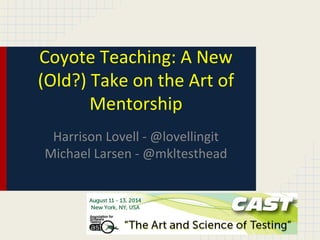Coyote Teaching: A New (Old) Take on the Art of Mentorship
- 1. Coyote Teaching: A New (Old?) Take on the Art of Mentorship Harrison Lovell - @lovellingit Michael Larsen - @mkltesthead
- 2. Michael Larsen Senior Quality Assurance Engineer, Socialtext Michael Larsen is Senior Tester located in San Francisco, California. Over the past seventeen years, he has been involved in software testing for products ranging from network routers and switches, virtual machines, capacitance touch devices, video games and distributed database applications that service the legal and entertainment industries. Michael writes the TESTHEAD blog and can be found on Twitter at @mkltesthead. Harrison C. Lovell Associate Engineer, QA, Virtusa Harrison C. Lovell is an Associate Engineer at VirtusaŌĆÖs Albany office. He is a proud alumnus from Per ScholasŌĆÖ ŌĆśIT-Ready TrainingŌĆÖ and STeP (Software Testing education Program) courses. For the past year, he has thrown himself into various environments dealing with testing, networking and business practices with a passion for obtaining information and experience.
- 3. Intro ŌĆó Skills Transfer/ Simplifying the process ŌĆó Fastest way to proficiency ŌĆó Their way, their experiences ŌĆó Different contexts. Metaphors and Analogies ŌĆó Lost in translation
- 4. RUAPA ŌĆó Read, Understand, Apply, Persist, Achieve ŌĆó Teach people to teach themselves ŌĆó Primitive: hunt, fish, knots ŌĆó Un-evolved people. ŌĆó We arenŌĆÖt smarter. ŌĆó Tech veneer. ŌĆó Double Edge sword ŌĆó Tribal skills
- 5. What is Coyote Teaching? ŌĆó Tom Brown, Jr and Jon Young ŌĆó No direct answers, ans. w/ questions, dig deeper, embed and connect lessons ŌĆó Inspires to independency ŌĆó Adapt to teaching style
- 6. Coyote Teaching: Extended ŌĆó Limited habitat. Man shapes their environment. Adapting is key ŌĆó World of extremes, unlike other creatures, can settle anywhere ŌĆó Go beyond ŌĆ£learn and youŌĆÖll be okayŌĆØ
- 7. Becoming a Coyote ŌĆó State the obvious ŌĆó Trickster myths. Pair hunting. Small size ŌĆó Observed behavior = Core teaching approach ŌĆō Unique skills ŌĆō Engagement ŌĆó Passing on traditions
- 8. Environmental Saturation ŌĆó Allow people to utilize the environment they are in ŌĆó Start where you are, use what you have, build what you need ŌĆó Authentic problems
- 9. Creating a Need ŌĆó Snowboarding ŌĆó Balance point ŌĆó Analogy that I would understand ŌĆó Five gallon water bottle
- 10. Art of Questioning ŌĆó Focus on giving the answer to a question ŌĆó Comprehending what we are presenting ŌĆó Answer to make us happy ŌĆó Socratic Method ŌĆō answering questions with more questions
- 11. Trickster/ Transformer ŌĆó Transforming the situation ŌĆó Calvin and Hobbes ŌĆó a curve ball
- 12. Story-Telling Culture ŌĆó Tribal societies ŌĆó Analogies are frequently used ŌĆó Simple analogies vs full story-telling
- 13. Edge Experiences ŌĆó What makes a story more exciting? ŌĆó Different type of experiences ŌĆó Strong emphasis on stretching rather than freaking someone out ŌĆó Edge case examples
- 14. Edge Case ŌĆó Stepping out of comfort zone ŌĆó Line between growing and freaking out ŌĆó Push effectively without pushing you off the edge
- 15. Constraints and Taboos ŌĆó Idea of Taboo ŌĆó Strong word ŌĆó Learning with constraints ŌĆó Children, Tech, and Boarders ŌĆó Interchangeable
- 16. Summary ŌĆó This stuff is HARD ŌĆó Principles can be applied on a continuum ŌĆó Level of relationship and commitment informs the level of mentoring ŌĆó Limitless potential, if both are willing to invest ŌĆó When one is raised by a Coyote, one becomes a Coyote.
















